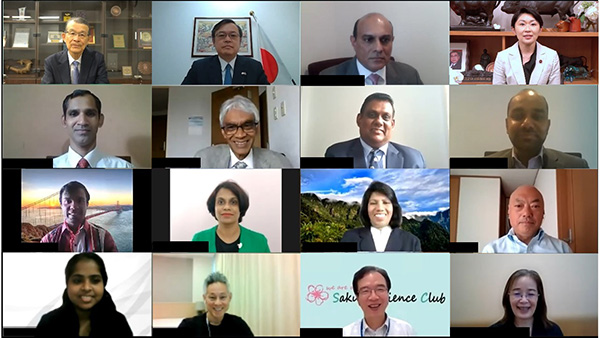Events
2nd Sri Lanka Alumni Meeting Showed Opportunities and the Way Forward
On June 26, 2021 the much-awaited 2nd Sri Lanka Alumni Meeting was conducted online in collaboration with Sakura Science Club Alumni Association of Sri Lanka (SSCAASL), and National Science Foundation Sri Lanka (NSF) and Japan Science and Technology Agency (JST). Mr. J.G. Shanta Siri, Head of International Liaison Division from NSF moderated the meeting.
After encouraging remarks from Dr. Thamara Dias, Additional Director of NSF and Dr. KISHI Teruo, Director General of Sakura Science Program Headquarters, Ms. OBUCHI Yuko, Member of Japan’s House of Representative (Chief Secretary, Sri Lanka Japan Parliamentary Friendship Association), Ambassador SUGIYAMA Akira at the Embassy of Japan in Sri Lanka and Ambassador Sanjiv Gunasekara from the Embassy of Sri Lanka in Japan, guest speakers and alumni reassured how the program shed positive influences on students and researchers in and outside of Sri Lanka.

Messages by Guest Speakers on Opportunities in Japan
Prof. Monte Cassim
The first guest speaker was Prof. Monte Cassim, President of Akita International University, who made clear that his experience coming to Japan changed the course of his life. He wanted to tell Sri Lankan students about the great opportunities available for them in Japan. He urges students to commit themselves to excellence, but to also “keep an eye on the big picture.”
Prof. Monte Cassim’s presentation material
Dr. H.D. Karunaratne
The second guest speaker, Dr. Karunaratne, Director of the University of Tokyo Sri Lanka Office in Colombo, discussed the “Study in Japan Global Network Project”. His team communicates with high school students across Sri Lanka about opportunities in Japan. They have conducted 46 programs across the country, communicating with over 5,800 students. They help students enroll in the PEAK (Programs in English at Komaba) program, which offers two 4-year undergraduate degrees and two graduate-level degrees. Dr. Karunaratne hopes to “increase the number of good students going to Japan in the near future.”
Know more from
https://www.facebook.com/UTokyoSriLanka/
JST Calls Out to Sri Lankan Researchers for International Collaboration
The next two presentations were from JST, introducing the funding agency’s international joint-research schemes. Dr. Kawabata Ken, Special Program Coordinator at the Secretariat of e-ASIA introduced the e-ASIA JRP (Joint Research Program) and Mr. Aoki Kazuhiko of JST’s India Liaison Office introduced SATREPS. They eagerly called out to Sri Lankan researchers to participate in the call for research proposals.
Know more from
https://www.the-easia.org/jrp/
https://www.jst.go.jp/global/english/index.html
During the break, the organizers aired a short video created by alumnus Mr. Dhaneja Meegoda who visited Japan in 2019. In the last part of the webinar three Sri Lankan SSC members shared views based on their experiences and outlook on the program.
Presentation by Alumni: Feedback and the Way Forward
Ms. Amali Herath
First, Ms. Herath spoke about how the Sakura Science Program shaped her career. In 2018, she came to the University of Miyazaki for a 10-day program as an undergraduate student in mechanical engineering.
Ms. Herath’s major takeaways were the value of information exchange and how such exchange can lead to products that help society. The products she learned about were designed by researchers who stayed true to their cultural values. She felt that this integrity resulted in products with clear purpose for real people.
Mr. Charith Premachandra
In addition to his experiences gained through the program, Mr. Premachandra outlined engineering education in Sri Lanka. There are 6 engineering faculties in government universities, and about 2000 student-intake per year. Sri Lankan engineering students have produced outstanding achievements like unmanned aircraft and F1 cars, so it is no surprise that over 90% of graduates are employed shortly after graduation.
To enhance the program, he suggested the following:
1) To increase the number of available SSP slots per year;
2) To launch a support scheme for postgraduate students to find prospective supervisors in Japan;
3) To create internship opportunities in Japan; and
4) To invite outstanding alumni-researchers back to Japan for collaboration.
Dr. Nanda Gunawardhana
The final speaker was Dr. Nanda Gunawardhana, Director of International Affairs and Research for the Sri Lanka Technological Campus (SLTC). He introduced the Sri Lanka-Japan Study Center (SLJSC), which started in 2013 to strengthen research cooperation, and to support exchange programs between universities of both countries. Since 2017, SLJSC has sent out several groups of students to experience engineering at Japanese universities. There are many positive reviews so far.
As a way forward, he hopes to make Sakura Science one of the most active programs in south Asia. As a part of the Sakura Science High School Program, he proposed that JST and NSF can jointly provide online courses and social interaction for students, as well as online university lectures involving Japanese scholars.
To close the webinar, Mr. Kuroki Shinichi, Director at the Department of Planning and Management, Sakura Science Program Headquarters and Ms. Dilrukshi Ekanayake, NSF Senior Scientific Officer / SSCAASL Main Coordinator thanked everyone and applauded the success of this webinar. To know more about each presentation, please view this meeting’s video uploaded on Sakura Science Club YouTube Channel.







